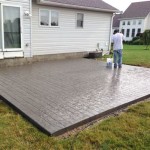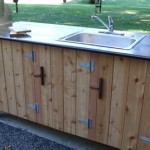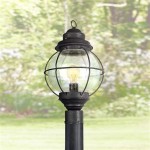How To Treat Wood For Outdoor Use
Wood, a versatile and aesthetically pleasing building material, is frequently used in outdoor applications ranging from decks and fences to furniture and siding. However, unprotected wood is susceptible to damage from the elements, including moisture, sunlight, insects, and fungi. Consequently, proper treatment is crucial to extending the lifespan and maintaining the appearance of wood used outdoors. This article provides a comprehensive guide to treating wood for outdoor use, covering various methods and considerations for ensuring its durability and longevity.
The primary goal of treating wood for outdoor use is to prevent decay and degradation caused by biological agents and environmental factors. Wood decay fungi thrive in moist environments, breaking down the wood's structure and leading to rot. Insects, such as termites and carpenter bees, can also infest wood, causing structural damage. Additionally, exposure to sunlight, particularly ultraviolet (UV) radiation, can cause the wood to fade, discolor, and become brittle. Moisture, in the form of rain, snow, or humidity, is a major contributor to wood decay and can also cause warping, cracking, and swelling.
The selection of the appropriate treatment method depends on several factors, including the type of wood, the intended use, the level of exposure to the elements, and the desired aesthetic appearance. Certain wood species, such as cedar, redwood, and cypress, are naturally more resistant to decay and insects than others, but they still require treatment for optimal performance. The severity of the environment, such as proximity to saltwater or areas with high humidity, will also influence the choice of treatment. Finally, the desired finish, such as a natural look or a painted surface, will further dictate the appropriate treatment method.
Understanding Wood Preservatives
Wood preservatives are chemical substances that protect wood from decay, insects, and other forms of degradation. These preservatives work by either killing the organisms that attack wood or by making the wood less hospitable to them. There are several types of wood preservatives available, each with its own advantages and disadvantages. It is important to select a preservative that is appropriate for the specific application and wood species.
Waterborne Preservatives: These preservatives are dissolved in water and applied to the wood. They penetrate the wood fibers and provide long-lasting protection against decay and insects. Common waterborne preservatives include alkaline copper quaternary (ACQ), copper azole (CA), and borates. ACQ and CA are effective against a broad spectrum of decay fungi and insects, while borates are primarily effective against insects and are often used in interior applications or in areas with low moisture exposure. Waterborne preservatives are generally odorless and paintable.
Oil-borne Preservatives: These preservatives are dissolved in oil and applied to the wood. They provide excellent protection against decay and insects, and they are particularly effective in preventing water absorption. Common oil-borne preservatives include creosote and pentachlorophenol (PCP). However, creosote and PCP are restricted in many areas due to their toxicity and environmental concerns. Oil-borne preservatives typically have a strong odor and may not be paintable.
Light Organic Solvent Preservatives (LOSPs): These preservatives are dissolved in a light organic solvent, which allows them to penetrate the wood fibers quickly. LOSPs provide good protection against decay and insects, and they are often used for millwork and joinery. They are typically paintable and have a mild odor. However, LOSPs may not provide the same level of protection as waterborne or oil-borne preservatives in severe environments.
Choosing the right preservative is crucial. Factors such as the intended use of the wood, environmental regulations, and personal preferences should all be considered. Consulting with a professional wood treatment specialist is often beneficial in making an informed decision.
Methods of Applying Wood Treatments
The effectiveness of wood treatment depends not only on the type of preservative used, but also on the method of application. Proper application ensures that the preservative penetrates the wood fibers adequately and provides long-lasting protection. Several methods of applying wood treatments are available, each with its own advantages and limitations.
Brushing: Brushing is a simple and cost-effective method of applying wood preservatives. It is suitable for small projects and for treating areas that are difficult to reach with other methods. However, brushing may not provide as deep a penetration as other methods. Multiple coats are often necessary to achieve adequate protection. The key is to apply even coats and ensure the preservative fills all cracks and crevices.
Spraying: Spraying is a faster and more efficient method of applying wood preservatives than brushing. It is suitable for larger projects and for treating complex shapes. Spraying can provide a more uniform coverage than brushing, but it may also result in overspray and waste. Proper ventilation and personal protective equipment are essential when spraying wood preservatives. Different types of sprayers exist, from simple hand-pump sprayers to professional airless sprayers. The choice depends on the scale of the project and the viscosity of the preservative.
Dipping: Dipping involves immersing the wood in a tank of preservative for a specified period of time. This method provides good penetration and is suitable for treating large quantities of wood. Dipping is often used for treating lumber and timbers. The immersion time depends on the type of preservative and the wood species. Accurate monitoring of the immersion time is critical to ensure effective treatment without over-saturation.
Pressure Treatment: Pressure treatment is the most effective method of applying wood preservatives. It involves placing the wood in a pressure vessel and forcing the preservative into the wood fibers under high pressure. Pressure treatment provides deep and uniform penetration, resulting in long-lasting protection. Pressure-treated wood is commonly used for decks, fences, and other outdoor structures. This method is primarily done commercially and ensures the most comprehensive protection. It is important to note that pressure-treated wood often has a greenish tint due to the copper-based preservatives used, but it can be stained or painted to suit aesthetic preferences.
Preparing Wood for Treatment and Maintenance
Proper preparation is essential for ensuring that wood treatments are effective. Before applying any preservative, the wood should be clean, dry, and free of dirt, grease, paint, or other coatings that could prevent the preservative from penetrating the wood fibers. Furthermore, ongoing maintenance is critical to prolonging the life of treated wood.
Cleaning: The wood should be cleaned with a brush and soapy water to remove any dirt, debris, or mildew. For stubborn stains, a wood cleaner or brightener may be used. Allow the wood to dry thoroughly before applying the preservative. Power washing can be used, but care should be taken to avoid damaging the wood fibers. A mild detergent is generally sufficient for cleaning.
Sanding: Sanding the wood can help to improve the penetration of the preservative and create a smoother surface for painting or staining. Use a medium-grit sandpaper to remove any rough spots or splinters. After sanding, remove any dust with a tack cloth. Sanding also helps to remove any existing coatings or weathered surfaces that may impede preservative absorption.
Repairs: Before treating the wood, inspect it for any signs of damage, such as cracks, splits, or rot. Repair any damage before applying the preservative. Small cracks can be filled with wood filler, while larger cracks or splits may require more extensive repairs. Addressing these issues early prevents further deterioration.
Maintenance: Regularly inspect treated wood for signs of wear and tear. Reapply the preservative as needed, typically every one to three years, depending on the type of preservative and the level of exposure to the elements. Clean the wood regularly to remove dirt and debris. Consider applying a water-repellent sealant to further protect the wood from moisture damage. Routine maintenance is key to maximizing the lifespan of outdoor wood structures.
In addition to these general guidelines, it is important to follow the manufacturer's instructions for the specific wood preservative being used. Different preservatives may have different application requirements and safety precautions. Always wear appropriate personal protective equipment, such as gloves, goggles, and a respirator, when working with wood preservatives.
By understanding the principles of wood preservation and following these guidelines, one can effectively treat wood for outdoor use and ensure its durability and longevity. Investing in proper wood treatment is a cost-effective way to protect outdoor wood structures from the damaging effects of the elements and biological agents, preserving their beauty and extending their service life.

How To Seal Wood For Outdoor Use Diy

How To Seal Wood For Outdoor Use Extreme

How To Treat Wood For Outdoor Use 3 Methods Explained

When And How Often To Treat Outdoor Wood Finishes Direct

Treating Staining Pallets For Outdoor Use Aaa Pallet Lumber Co

How To Treat Wood For Outdoor Use On A Budget

6 Ways To Treat Wood For Outdoor Use Pine And Poplar

How To Treat Wood For Outdoor Use 3 Methods Explained

How To Treat Wood For Outdoor Use

6 Ways To Treat Wood For Outdoor Use Pine And Poplar
Related Posts








